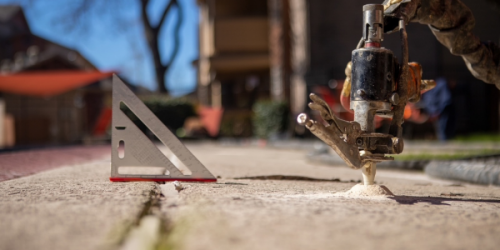Q&A Forums
Maximum effective depth Post New Topic | Post Reply
| Author | Comments |
|---|---|
|
stevie berman
Posted: Sep 23, 2008 01:11 AM
|
Maximum effective depth
I'm a builder who's insulating an unvented cathedral ceiling in a remodel. Previously insulated with fiberglass and it rotted from the inside. Rafter depth is 7" (it has been furred down). After researching, a minimum of 3" ccSPF seems like the way to go. I'd like to get to R-38 (code for my area). It's a relatively small area, 600 sq ft, so I don't mind adding more ccSPF to achieve a higher insulative value. I've heard from several experienced foam applicators that anything over 5.5" of ccSPF is overkill. Do you agree? |
|
mason
Posted: Sep 23, 2008 05:19 PM
|
There comes a point where the added foam doesn't provide cost effective insulation. It will vary depending on the difference in temperature between the interior and the exterior. For example in South Texas, temperature 95 degrees average, and a cold storage temperature of -10 degrees, the cost effective thickness of closed cell SPF was around 5 to 6 inches. However, your code official may insist on full R value thickness of R 38 unless you provide them with research data that demonstrates lessor R values of ccSPF provide the equivalent insulative value of other insulation with higher R values. SPFA has conducted comparison tests in attics and walls that show a 20 to 35 % greater energy efficiency than fiberglass insulated walls and attics in similar climate conditions. Contact Rick Duncan at SPFA for test results. |
|
Jim Coler
Posted: Sep 24, 2008 09:06 AM
|
We run into this issue with code officials all the time and some of them will not budge - or use any common sense. All some of them want to see is a number stamped on the product or on the spec sheet per the installed thickness. Mason is right Fiberglass performs 20-35% less than it's stated R-value- when the fiberglass is "installed perfectly". Trust me when I say this never happens and can't happen the way these tests were conducted. (They left the outside sheathing off and plucked the FG in all corners and around everything to make sure it was best case scenario. - Who plucks their insulation from the outside?) So, realistically, Fiberglass performs worse than the 20-35% less than the stated R-value and A BPI contractor is trained to assess Fiberglass starting at about 75% of the stated R-value. It goes down from there and is typically in the 20-50% of stated R-value range from the way it's typically installed, longevity, compression, ect. It's even worse in an attic where rodents got in and made super highways. So Mason, when will the industry come out with a real measurement system which takes into account the performance of foam? Right now, it favors Fiberglass because that's what the codes are based on and it's really frustrating to educate some of the code officials when they think they know it all. (How much water do you fit in a bucket when it's already full? - none) That's the way I feel sometimes with some of these knuckle head code officials. Don't get me wrong - I know of a couple who walk in the building and say, "Oh, you're using spray foam, you're good!" and walk back out. These are the guys who have done the research and know the value of the foam. |
|
mason
Posted: Sep 25, 2008 08:20 AM
|
One ongoing initiative that I have supported for many years is to develop testing procedures that can quantify the comparative energy performance of walls, ceilings and roofing systems. I have been actively involved in proto-type testing of this type at Oakridge National Labs, Architectural Testing Inc. and at Syracuse University. Results from this testing is available from SPFA. Contact their new Technical Director Rick Duncan for details and reports. Also, support SPFA's efforts in this field with your membership and support. After the testing has been validated, then it needs to be accepted by the rest of the construction community and finally by the building code community. Some of the SPF suppliers have been aggressively pushing ICC Evaluation Services to officially recognize the ASTM C 1363 test procedure modifications used at ATI (testing insulated wall assemblies with air pressure differential)in order to obtain evaluation reports demonstrating that lessor R values of SPF can be used to provide an energy performance equivalent to the prescriptive R value table of the codes. Let SPFA and your supplier know that this is important to you so that funding and a consensus within the insulation community can be achieved. |
|
quentin
Posted: Sep 25, 2008 01:01 PM
|
One of the things I have heard is that at 3.5 inches you have acchived 98% efficiency anyways and after that the cost returns are pretty negligable. Your thoughs on that? |
|
Jim Coler
Posted: Sep 26, 2008 06:58 AM
|
Quentin, I think you're referencing the percentage heat loss chart that SPFA put out a couple of years ago. It shows that at 3.5" it's about 95% efficient at blocking the heat. You add another inch of foam and you get about .3 of % increase. So, it's the point of diminishing returns. And it is different between open and clsed cell because of the different heat transfer coefficient of the materials. This will also be different between blowing agents. |
|
Jim Coler
Posted: Sep 26, 2008 07:02 AM
|
Mason, I agree with the efforts put forth so far and have been aware of them, but it still doesn't completely help the SPF community. The fact is that the codes are based on "R-value" and the unwritten basis this came from is this is Fiberglass Stated R-values which performs at much lower than stated in real life. So, the problem isn't showing that foam performs better because the code doesn't have any requirements for how it performs. the Problem is that R-value is not a fair and performance based measurement. I know we're up against some big guns with the fiberglass industry, but let's get back to calling something wrong when it is wrong. So, we need a new measurement system for heat resistance under performance. Does that mean that fiberglass would have to lower their "R-values" to realistic values? Where does the FTC stand with misleading R-values like fiberglass. A greta example is a 2" thick fiberglass panel system sold for basement exterior walls. They are publishing an R-11 for this. COME ON! Performance wise, they're lucky if they get an R-1 once it gets wet. This is the crap we need to stop. |
|
mason
Posted: Sep 26, 2008 09:01 AM
|
The effective thickness varies with the delta T. The colder environments can benefit from more than 3.5 inches of foam, but I wouldn't put more than 6 inches in even in the coldest environment. |
|
mason
Posted: Sep 26, 2008 09:03 AM
|
The FTC updates the R value rule every 10 years or so. The last time was in 2003. ASTM C 1029, C 578 and 1289 (representing closed cell SPF, EPS and polyiso respectively) reflect the current FTC required testing procedures. We are a long way from FTC requiring the insulation industry to test the products for comparison purposes in real world environments that include great temperature difference, thermal bridging, convection and air infiltration. We are closer in modifying the codes to take those into account. |





























